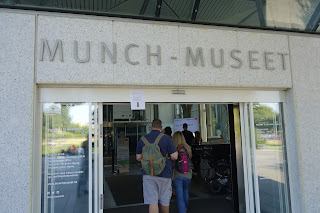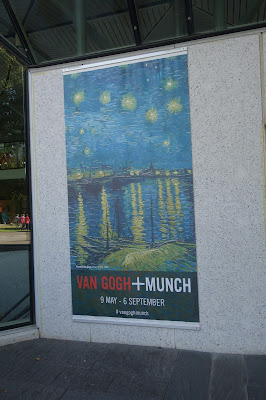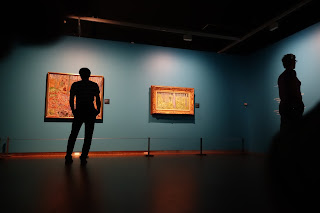Our next to last day in Oslo started with a trip to City Hall. City Halls tend to be the dominant buildings in Scandinavian capitals, rather than churches. Perhaps that’s why Scandinavia always ranks so high on the list of countries with happy, satisfied people. Here, people pay high taxes, have high expectations, and usually get what they expect: a government that cares about its citizens and spends their money wisely, i.e. free health care, free universities, and well paying jobs.
Construction of City Hall began in 1931. After a WWII delay, it was completed in 1950, to celebrate the city’s 900th birthday. Norway’s leading artists all contributed to the building. It was meant to be a grandiose statement of civic pride, and it is.

Inside, you’ll find a celebration of the working class, with 20,000 square feet of bold and colorful murals showing town folk, country folk, and people from all walks of life working harmoniously for a better society.
The murals give you a history of Norway and are a good reflection of the mindset of Norwegian society. You go from the simple rural beginnings, through the Nazi occupation and beyond.
The Nobel Peace Prize is award in this central hall each December. There was a display showing several past winners. Featured prominently was Obama getting the award.
There’s Barack and Michele at the ceremony.
Out front, as you enter the building, there re side galleries adorned by wood panels illustrating pagan Nordic myths with several featuring Yggdrasil, the Tree of the World.
On the waterfront side there are six statues, all dating from a period of Labor Party rule in Norway. The statues celebrate the nobility of the working class.
Finally, on the west side of the building, on the wall is a tribute to Fridtjof Nansen, the Arctic explorer, diplomat, and humanitarian who I wrote about in yesterday’s blog post. He was an amazing man and deserved this tribute.
After spending the morning at City Hall, we went back to the harbor to catch the hop-on hop-off mini-cruise which is free for holders of the 72 hour Oslo Pass. The next stop after City Hall is the Opera House, our next destination.
Den Norske Operahuset – the Opera House – is one of the city’s proudest and newest buildings. Completed in 2008, it is home to the city’s opera and ballet companies. Designed by the Norwegian company Snøhetta, it has exterior ramps that look like ski slopes. It’s meant to impress, and it does. No expense was spared constructing the Opera House, and since its opening, Norwegians have visited in the thousands. The Opera House is a key part of an ambitious long-term project to transform the city’s waterfront. This plan includes moving the Munch Museum (our next stop) to the harbor, in yet another glossy glassy building.
The main theater holds 1400 seats and has amazing state-of-the-art acoustics.
The roof of the building doubles as a public plaza. You can walk all over it. When there are concerts or other events here, there will be thousands of people sitting on the roof, and the seating is perfect because the way the roof slopes, you’re always a little bit higher than the person in front of you, so your view is not obstructed.
A tour guide said that the building is the most popular tourist attraction in Oslo, and it is also the most popular public space in Oslo as well. Olso residents consider the Opera House to be “their living room”, she said. The Opera House looks pretty cool on the approach from the water. The long white roof does indeed look like a ski slope
You can see people milling about on the top of the roof.
Pretty cool glass sculpture in the harbor by the Opera House.
We landed and headed toward the entrance, but decided to stroll on the roof before going in.
Nice view of the city, looking west from the roof.
We managed to tear ourselves away from the sunny rooftop and headed inside.
Inside was impressive. You look up from the lobby below and see the rotunda above.
Up the stairs, you get to the actual auditorium. No photos were allowed, but that never stops me, of course.
Back down in the lobby, they had displays of the costumes from past performances.
Upstairs, they had an exhibit for kids (primarily), where you get to try on some of the costume props from past performances. This is where we got a little silly.

They offered a guided tour in English at 2:00. We were shown everything – how the costumes are designed and made, where the set pieces are constructed, how the special effects on stage are generated. It was very interesting. We got stand behind the stage. Photos were forbidden, but I managed to sneak one:
An amazing building. That evening was the opening performance of The Barber of Seville. Unfortunately, it was completely sold out. Not one seat available, even obstructed view. Oh well. Reason to come back.
The Oslo train station is nearby, and we were finally getting to use Oslo’s metro system. Till now, it had just been trams or walking. Like everything in Oslo, it was sparkling clean and efficient.

One mile east of Oslo’s center is a museum devoted to the world of the only Norwegian painter to have had a serious impact on European art, Edvard Munch.

The Munch Museum was in the news in August of 2004, when two Munch paintings, Madonna and a version of his famous Scream were brazenly stolen right off the walls in broad daylight. Two men in black hood simply entered through the museum cafe, waved guns at the stunned guards and tourists, took the paintings off the wall, and sped off in a a black Audi station wagon. In 2006, the thieves were caught and the stolen paintings recovered. Now, they have beefed up security. We had to go through a scanner and have our bags scanned as well, before seeing the exhibits.


On the day we went, they were in the midst of their current exhibit “Van Gogh + Munch”. I thought it was quite a stretch, trying to compare these two artists. Most of the placards began with “Although the two artists never met…” or “Despite having very different brushstrokes…” I had already seen most of van Gogh’s work at the Van Gogh Museum in Amsterdam (and I see his Starry Night regularly, as I live in New York and am a member of MoMA), I never get tired of looking at his paintings, and it was nice to see two great artists in one exhibit. They had both Madonna and The Scream on exhibit, both protected by plexiglass. Photos were strictly forbidden, but again, I managed to sneak one, just to show what the museum looked like. Tomorrow I knew I’d get to see more Munch at the National Gallery.
It was still early, and we didn’t have much of an agenda after the museum, so I suggested we check out the hip neighborhood Grünerløkka again, but this time not looking for particular landmarks that they pointed out in the guidebook, but just stroll the neighborhood like locals, popping in and out of stores, and going down streets that were off the main drag. While walking, we stumbled upon the little park in the center of the neighborhood. Last time, it was pretty quiet. Today was a big festival with live music and lots of street food, mostly Thai.
This was definitely a local event. Very few tourists. We got some Thai food, found a nice spot on the grass, and ate lunch while listening to the music. I took some photos of the folks of Oslo just being Norwegian.

On the perimeter of the park were a cluster of popular cafes with outdoor seating. They all looked so nice. Things like this make you want to come back here again and again.
Since the daylight lasts forever, we continued strolling, going way off the beaten path, choosing to stroll down any street that looked interesting.

We came upon something. Turned out to be the Natural History museum, which was closed. But the park and botanical gardens connected to it were still open, so we ventured in.

The botanic gardens were beautiful. I had plenty of time to play with the settings on my camera, using the illustration setting to add outlines to the leaves, and the high dynamic range setting to really enhance the color, Pretty neat, huh?

There was an herb garden, and scattered throughout the fields were a few sculptures, like this one of a giant apple made of branches and fibers.
Dinner time was approaching, so we headed back toward Gronland, the neighborhood adjacent to Grunerlokka. As I mentioned yesterday, Gronland is more gritty and ethnically diverse than Grunerlokka.
We weren’t actually very hungry. The Thai street food that we had purchased at the festival had us still pretty full, so we went back to the hotel, and ate dinner later at a place nearby. So ends our last full day in Oslo. Tomorrow we have a few sights to see in the morning before heading back to the airport.
 We came upon something. Turned out to be the Natural History museum, which was closed. But the park and botanical gardens connected to it were still open, so we ventured in.
We came upon something. Turned out to be the Natural History museum, which was closed. But the park and botanical gardens connected to it were still open, so we ventured in.



















